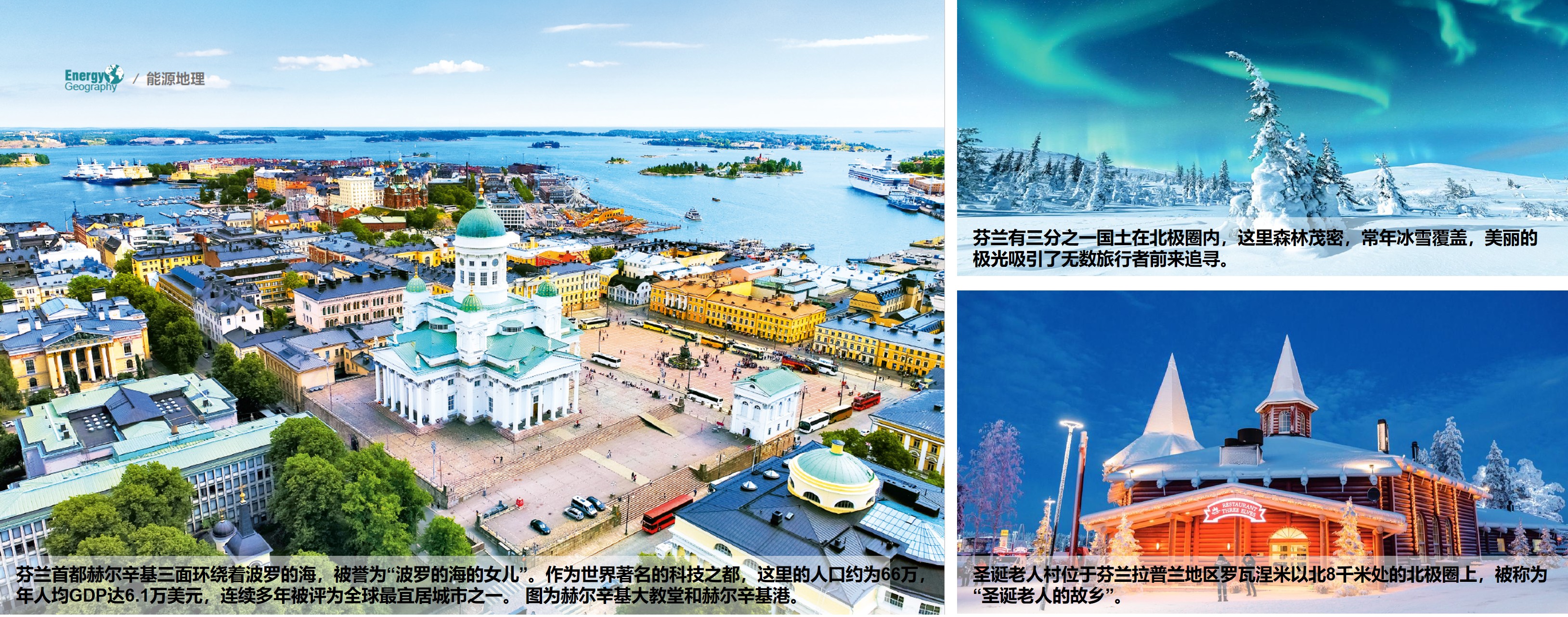
 LANGUAGE
LANGUAGE
Located in a cold and bitter land, our ancestors were poor and penniless. When Finland gained independence in 1917, it was still a poor agricultural country with limited arable land to the point where agricultural products could only be self-sufficient. However, in just 100 years, it developed into one of the successful examples in the "global village" - with an annual per capita GDP of over $50000, a small wealth gap, a well-established social welfare system, and citizens' work life balance and high sense of happiness.
In promoting energy transition and ecological development, Finland has committed to achieving the goal of "carbon neutrality" by 2035, releasing the world's first circular economy roadmap, and setting a world benchmark in circular industries such as renewable energy, green building materials, and water treatment. In recent years, through cooperation with countries such as China that have mature experience in the new energy industry, we have jointly promoted green and low-carbon development.

Nature bestows the spirit of 'SISU'
Finland is located in northern Europe, with one-third of its territory within the Arctic Circle. The polar days, nights, and long winters have deeply influenced the character of the Finnish people. The land here is relatively barren, and agricultural output is also very limited. In history, the weak Finland was ruled by its "strong neighbors" Sweden or Russia for a long time, but the Finnish people who survived in harsh natural environments always maintained their own culture. Finns have four "S's", namely SISU, sauna, and the hometown of classical musician Sibelius and Santa Claus, which are cultural symbols that make Finns proud.
Finland has dense forests, numerous lakes, and scattered islands, making it easy for people to feel isolated from each other due to geographical factors. However, Finnish people have also become accustomed to drawing strength and comfort from nature, which is manifested in the form of sauna baths. Finland, with a population of only 5.5 million, has over 2 million saunas. Traditional Finns like to hide from the cold, meet guests, and dine in small saunas, and even the word "sauna" comes from Finnish. Finnish saunas are often built on the shores of lakes and seas covered in ice and snow. In the small wooden house with a blazing fire, charcoal from the vast forest roasts volcanic rocks from underground until they turn red, water pours on them, steam rises, and people sweat profusely in the sauna room at a temperature of up to 60-70 degrees Celsius. Then they open the door and dive into the cold natural water like quenched steel, experiencing the ultimate experience of ice and fire alternation.
In the process of natural refinement, the Finnish people have created a specialized term called 'SSU', which translates to 'perseverance and bravery' in Finnish, to express their national character. This is a simple and resolute spirit, as well as the ability to seek hope in adversity, self-discipline, moderation, and making wisdom and perseverance the most reliable resources. The Finnish people's love for "Sisu" is everywhere, and the Finnish icebreaker is named "Sisu", a popular candy brand among Finns also known as "Sisu".
During the war years, Finland relied on the spirit of the West Soviet Union for support. After World War II, the Finnish people regarded education as the cornerstone of national development, investing in education with national strength, attracting the best talents to the education system, promoting free education for all, and cultivating a large number of high-quality talents for Finland, accelerating the country's modernization transformation. With the help of abundant forest resources, Finland has started to promote industrialization from wood processing and paper industry. In the mid to late 20th century, well-educated Finns keenly grasped the arrival of the electronic and communication age, and quickly completed industrial layout. Nokia, which started with wood and cardboard business, is one of its representatives. Before the emergence of smartphones, this brand that had shifted its focus to the communication industry once held over 70% of the global mobile phone market share for more than a decade. Today, it still remains at the forefront of 5G technology and communication equipment.
After quickly entering the forefront of developed countries, Finns have not fallen into the trap of consumerism. They still advocate a return to simplicity lifestyle and maintain close connections with nature and all things. Finland has established a government with a high integrity index and achieved high welfare for all through high taxes, in order to completely eliminate poverty and support inclusive high-quality education, healthcare, and elderly care.
Technological innovation promotes green ecology
The spirit of "SISU" is not only reflected in the courage to challenge difficulties and venture into technology free zones, but also in the deep reverence and love for nature. Wood processing and papermaking were the basic industries in the early stages of industrialization in this country, which consumed a large amount of wood. However, sustainable forest management ensured that the country's forest coverage remained above 70% for a long time. As early as 1886, this country promulgated the world's first environmental protection related regulation, the Forest Law, which required that forests be replanted as soon as possible after logging. "For every tree cut, three seedlings are planted alive" has become a tradition of this nation. They also require that all wood used in industries can be traced back to prevent illegal logging, ensuring a balance between forest total, soil and water conservation, biodiversity, and economic development.
In the late 20th century, humanity gradually realized the severity of the climate crisis, and the concept of environmental and ecological protection became increasingly popular. Finland, which has always advocated sustainable development, became a pioneer in global green development. In 1990, Finland became the first country in the world to implement a carbon tax system. In recent years, this country has established a dedicated National Innovation Fund to encourage research institutes, enterprises, and communities to develop and use clean technologies, and to promote environmental protection experiences globally. At the same time, Finland has also introduced green enterprise loans to specifically support financing projects with environmental benefits. Under the implementation of multiple policies, this country has gained a dominant technological position in clean energy technology research, as well as water, air, and soil protection. The innovation and export of clean technology have also provided a new industrial engine for Finland's economic development.
The southern Finnish city of Lahti is a model in green economy and ecological innovation, and has been named the "European Green Capital" in 2021. Here, numerous enterprises and research institutions related to clean technology are gathered The exploration and application of renewable energy, waste management and circular economy, green buildings and water treatment, digitalization and intelligent solutions have been effective, and most energy needs can be met through biomass energy and waste to energy generation. Lahti also launched the world's first personal carbon trading application, encouraging residents to reduce carbon emissions. Its solid waste treatment technology covers the entire chain of garbage management, including garbage classification, collection, transportation, sorting, recycling, and reuse, achieving the resource and energy utilization of garbage. The export of sustainable urban solutions has also created high value-added industries for this city. The Wiki Eco Community in Helsinki is renowned for its sustainable architecture, with buildings in the Du district extensively using materials and other environmentally friendly materials, and adopting energy-efficient designs with solar panels and geothermal heating. Becoming a model of green building practice in Finland. Another exemplary city in the ring, Espoo, has a wastewater treatment rate of 100%. This city has advanced water treatment facilities and strict water quality monitoring systems, and uses innovative technology to recover nutrients and energy from wastewater
Finland's energy structure is dominated by renewable energy, especially biomass energy and hydropower. Finland, rich in peat resources, aims to achieve its carbon neutrality goal by 2035. Include the phasing out of coal in the national energy and climate plan, actively develop renewable energy such as wind power, nuclear energy, and green hydrogen to promote emissions reduction in areas such as electricity and transportation. In addition, Finland is vigorously promoting cogeneration technology, which leads the world in energy efficiency. This country also has rich experience in the fields of smart grid, energy storage technology, and carbon capture and storage.
China Finland cooperation and collaboration towards a 'new'
in recent years. China and Finland are actively cooperating in the green and low-carbon transformation of energy. In August 2022, the "Multi Integrated" Micro Energy Network Demonstration Project in Nansha, Guangzhou was completed and put into operation as the first batch of Sino Finnish energy cooperation demonstration projects. The project focuses on the three major physical cities of solid oxide fuel cells, solar energy collection systems, and bedrock energy storage systems, and carries out key technology research and development and demonstration project construction. A single set of solid oxide fuel cells with a capacity of 60 kilowatts was built, realizing the application of high-efficiency solar energy collection systems in distributed energy supply and cross seasonal energy storage of bedrock energy storage systems, with an annual heat storage capacity of 300 megawatt hours.
Finland is one of the important manufacturing bases for lithium battery cathode materials worldwide, with abundant key resources for lithium battery production such as cobalt, nickel, lithium, and graphite. The Finnish Ministry of Economy and the Finnish National Agency for the Promotion of Commerce stated that Finland occupies an important position in the global battery material supply chain and is competitive in the international battery industry due to its investment in raw material supply chains, high-quality infrastructure, solid knowledge base for battery industry development, and high proportion of renewable energy generation. According to Bloomberg's analysis, various signals indicate that Finland is seeking new investors to help it establish a new industry around electric vehicle batteries in the next five years.
In the field of batteries, cooperation between China and Finland is full of possibilities, and some Chinese new energy vehicle battery companies have already invested in Finland. As a leading battery material manufacturer, Ningbo Shanshan plans to invest 1.3 billion euros in Finland in 2023 to build the largest electric vehicle battery material factory in Europe. Cathode materials are a key component in the manufacturing of electric vehicle batteries. In 2024, Zhongwei Group's joint venture factory for lithium-ion battery cathode precursor materials in Finland obtained an environmental permit, and project construction was put on the agenda.
In the future, cooperation between China and Finland in the field of new energy will be further strengthened. According to the Joint Work Plan (2025-2029) signed by the two governments on promoting a new type of cooperative partnership between China and Finland for the future, the two sides have carried out more active and pragmatic cooperation this year.
In the field of energy transition, the competent authorities of both sides will strengthen policy dialogue and technical exchanges on the basis of existing energy cooperation, encourage innovation, focus on clean energy, smart energy networks, regional and industrial heating and cooling, building energy efficiency, energy technology innovation and other fields for cooperation, and make the use of non fossil resource energy production one of the key areas of energy cooperation. In the field of circular economy, China and Finland will continue to carry out policy, technology, investment and financing project exchanges, organize mutual visits and docking between circular economy related enterprises and stakeholders of the two countries, and encourage the adoption of new circular economy solutions and policies in areas such as construction and waste management. In the fields of climate, biodiversity, and environment, both sides will jointly implement the United Nations Framework Convention on Climate Change, the Paris Agreement, and the Kunming Montreal Global Biodiversity Framework, cooperate through multilateral initiatives to address climate change, protect biodiversity and the environment, improve sustainable land use, and develop more sustainable urban construction.
Article source:《Energy Review》; Author: Song Bingru